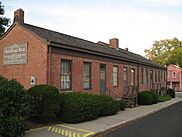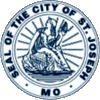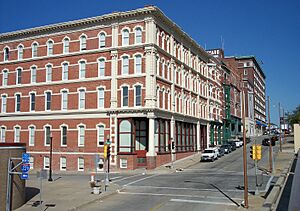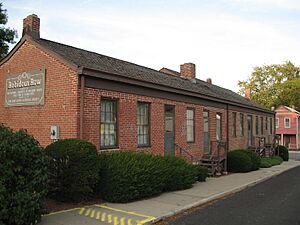St. Joseph, Missouri facts for kids
Quick facts for kids
St. Joseph, Missouri
|
|||||
|---|---|---|---|---|---|
|
Downtown St. Joseph, the Missouri River, and the Pony Express Bridge viewed from King Hill
Robidoux Row
Buchanan County Courthouse
Missouri Western State University
|
|||||
|
|||||
| Nickname(s):
St. Joe; The City Worthwhile
|
|||||
| Motto(s):
"Where the Pony Express started and Jesse James ended."
|
|||||
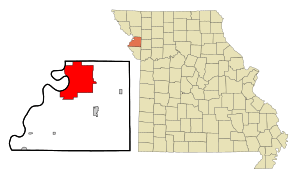
Location of St. Joseph in Missouri
|
|||||
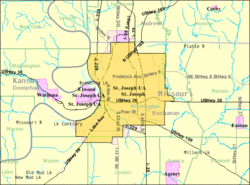
US Census map
|
|||||
| Country | United States | ||||
| State | Missouri | ||||
| County | Buchanan, Andrew | ||||
| Incorporated | 1843 | ||||
| Named for | Joseph Robidoux IV and Saint Joseph | ||||
| Area | |||||
| • Total | 44.82 sq mi (116.09 km2) | ||||
| • Land | 44.04 sq mi (114.05 km2) | ||||
| • Water | 0.79 sq mi (2.04 km2) | ||||
| Elevation | 889 ft (271 m) | ||||
| Population
(2020)
|
|||||
| • Total | 72,473 | ||||
| • Density | 1,645.77/sq mi (635.43/km2) | ||||
| Demonym(s) | St. Josephian | ||||
| Time zone | UTC−6 (CST) | ||||
| • Summer (DST) | UTC−5 (CDT) | ||||
| ZIP Code |
64501-64508
|
||||
| Area codes | 816, 975 | ||||
| FIPS code | 29-64550 | ||||
| GNIS feature ID | 2396498 | ||||
St. Joseph is a city in Andrew and Buchanan counties and the county seat of Buchanan County, Missouri, United States. Located on the Missouri River, it is the principal city of the St. Joseph Metropolitan Statistical Area, which includes Buchanan, Andrew, and DeKalb counties in Missouri and Doniphan County, Kansas. As of the 2020 census, St. Joseph had a total population of 72,473, making it the 8th most populous city in the state, and the 3rd most populous in Northwest Missouri. St. Joseph is located roughly thirty miles north of the Kansas City, Missouri, city limits and approximately 125 miles (201 km) south of Omaha, Nebraska.
The city was named after the town's founder Joseph Robidoux and the biblical Saint Joseph. St. Joseph is home to Missouri Western State University. In the nineteenth century, it was the death place of American outlaw Jesse James. It was also the starting point of the Pony Express serving the West.
Contents
History
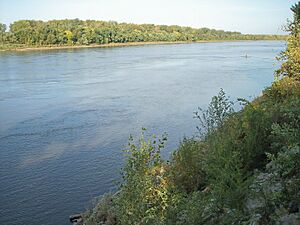
St. Joseph was founded on the Missouri River by Joseph Robidoux, a local fur trader of French Canadian descent. It was officially incorporated in 1843. In its early days, it was a bustling outpost and rough frontier town, serving as a last supply point and jumping-off point for travelers on the Missouri River toward the "Wild West". It was the westernmost point in the United States accessible by rail until after the American Civil War.
The main east–west downtown streets were named for Robidoux's eight children: Faraon, Jules, Francois (Francis), Felix, Edmond, Charles, Sylvanie, and Messanie. The street between Sylvanie and Messanie was named for his second wife, Angelique.
St. Joseph, or "St. Joe", as it was called by many, was a "Jumping-Off Point" for those migrants headed to the Oregon Territory in the mid-1800s. Such cities, including Independence, and St. Joseph, were where pioneers would stay and purchase supplies before they headed out in wagon trains across the Great Plains. The town was a very lively place.
Between April 3, 1860, and late October 1861, St. Joseph was one of the two endpoints of the Pony Express, which operated for a short period over the land then inaccessible by rail, to provide fast mail service. Today the Pony Express Museum hosts visitors in the former stables of the company. St. Joseph is identified by the slogan, "Where the Pony Express started and Jesse James ended."
The town's main hotel was Patee House. In the post-Civil War years, when the economy was down, the hotel was used for a time by the Patee Female College. It was occupied by the St. Joseph Female College up to 1880.
In 1874 the State Lunatic Asylum #2 was opened just East of St. Joseph. The asylum, originally built for 250 patients opened its doors with more than 300. The asylum was mostly self-sustaining with 3 large farms, power plant, fire department, metal shops, wood shops, dairy and more, all worked by the patients. Over the decades the asylum grew rapidly, reaching its peak of close to 3,000 patients by the 1940s. In 1968 occupational therapist George Glore with the help of his patients, recreated several historic treatment devices for Mental Health Awareness Month. This was the start of the Glore Psychiatric Museum. Now the largest museum of its kind in the world, the Glore shows the history mental health treatment and still houses the original exhibits created by George Glore and his patients. You can visit the Glore Psychiatric Museum, housed in the former Surgical and Outpatient Center of the hospital, 7-days a week from 10AM-5PM.
Outlaw Jesse James lived here under the alias "Mr. Howard". The song, "Jesse James", includes the lines, "...that dirty little coward that shot Mr. Howard has laid poor Jesse in his grave." On April 3, 1882, James was killed at his home, originally located at 1318 Lafayette. It has been relocated next to the Patee House and still has the visible bullet hole from the fatal shot. It is now operated as the Jesse James Home Museum.
The Heaton-Bowman-Smith Funeral Home maintains a small museum about Jesse James. Their predecessors conducted his funeral.
St. Joseph was the second city in the US to install electric streetcars; regular service was initiated on July 4, 1888. Among properties listed on the National Register of Historic Places are Robidoux Row, buildings owned by the founder and used for his family trading and mercantile business; the Patee House, now serving as a museum displaying St. Joseph's history, and the Missouri Theatre, an ornate movie palace. The Walnut Park Farm Historic District near St. Joseph was listed on the National Register of Historic Places in 1999.
St. Joseph's population peaked in 1900, with a census population of 102,979. This population figure is questionable, as civic leaders were known to have tried to raise the numbers for that census. At the time, Saint Joseph was home to one of the largest wholesale companies in the Midwest, the Nave & McCord Mercantile Company, as well as the Hannibal and St. Joseph Railroad, and the C.D. Smith & Company. C.D. Smith later became C.D. Smith Healthcare.
Prior to 1954 and desegregation, Bartlett High School served St. Joseph's African American students. It became Horace Mann Elementary with desegregation. St. Joseph's African American community leaders and Nathaniel C. Bruce were involved in and supported the establishment of Bartlett Agricultural and Industrial School in Dalton, Missouri. It was modeled after Tuskegee Institute and Hampton Institute.
Geography and climate
Saint Joseph is located on the Missouri/Kansas border in northwestern Missouri, also close to Nebraska; Iowa is another 70 miles farther north. The nearest major metropolitan area to St. Joseph is the Kansas City Metropolitan Area, which begins approximately 30 miles (48 km) to the south. The nearest major airport is Kansas City International Airport, which is approximately 35 miles (56 km) to the south. According to the United States Census Bureau, the city has a total area of 44.77 square miles (115.95 km2), of which 43.99 square miles (113.93 km2) is land and 0.78 square miles (2.02 km2) is water.
Under the Köppen climate classification, St. Joseph has a humid subtropical climate (Cfa) bordering on a humid continental climate (Dfa), although under United States isotherms of 32 °F (0 °C) the station is firmly continental. The monthly weather averages listed below are taken from National Weather Service 1981–2010 normals recorded at Rosecrans Airport. Because of the airport's location near the Missouri River and at a low elevation, official overnight lows during wintertime especially are often several degrees colder than at other places within the city. Snowfall is not recorded at the St. Joseph weather station although surrounding reporting stations typically receive 12-20 inches of snowfall annually.
| Climate data for St Joseph, Missouri (Rosecrans Memorial Airport), 1991–2020 normals, extremes 1908–present | |||||||||||||
|---|---|---|---|---|---|---|---|---|---|---|---|---|---|
| Month | Jan | Feb | Mar | Apr | May | Jun | Jul | Aug | Sep | Oct | Nov | Dec | Year |
| Record high °F (°C) | 73 (23) |
83 (28) |
98 (37) |
96 (36) |
103 (39) |
105 (41) |
108 (42) |
110 (43) |
107 (42) |
97 (36) |
82 (28) |
73 (23) |
110 (43) |
| Mean maximum °F (°C) | 61.7 (16.5) |
65.1 (18.4) |
79.7 (26.5) |
86.9 (30.5) |
91.9 (33.3) |
95.0 (35.0) |
97.4 (36.3) |
96.9 (36.1) |
92.7 (33.7) |
87.5 (30.8) |
74.0 (23.3) |
63.8 (17.7) |
99.0 (37.2) |
| Mean daily maximum °F (°C) | 37.4 (3.0) |
42.8 (6.0) |
55.1 (12.8) |
65.9 (18.8) |
75.8 (24.3) |
84.7 (29.3) |
88.1 (31.2) |
86.2 (30.1) |
79.7 (26.5) |
67.8 (19.9) |
53.4 (11.9) |
41.1 (5.1) |
64.8 (18.2) |
| Daily mean °F (°C) | 27.3 (−2.6) |
32.0 (0.0) |
43.3 (6.3) |
53.8 (12.1) |
64.8 (18.2) |
74.2 (23.4) |
77.7 (25.4) |
75.3 (24.1) |
67.0 (19.4) |
55.3 (12.9) |
42.0 (5.6) |
31.1 (−0.5) |
53.6 (12.0) |
| Mean daily minimum °F (°C) | 17.1 (−8.3) |
21.2 (−6.0) |
31.5 (−0.3) |
41.8 (5.4) |
53.7 (12.1) |
63.8 (17.7) |
67.3 (19.6) |
64.5 (18.1) |
54.4 (12.4) |
42.8 (6.0) |
30.6 (−0.8) |
21.1 (−6.1) |
42.5 (5.8) |
| Mean minimum °F (°C) | −4.3 (−20.2) |
2.5 (−16.4) |
12.4 (−10.9) |
25.0 (−3.9) |
38.0 (3.3) |
51.0 (10.6) |
55.8 (13.2) |
52.3 (11.3) |
39.1 (3.9) |
25.2 (−3.8) |
14.4 (−9.8) |
1.1 (−17.2) |
−8.7 (−22.6) |
| Record low °F (°C) | −25 (−32) |
−23 (−31) |
−13 (−25) |
2 (−17) |
29 (−2) |
41 (5) |
41 (5) |
41 (5) |
30 (−1) |
11 (−12) |
−5 (−21) |
−24 (−31) |
−25 (−32) |
| Average precipitation inches (mm) | 0.71 (18) |
0.95 (24) |
2.06 (52) |
3.71 (94) |
4.87 (124) |
4.75 (121) |
4.73 (120) |
3.84 (98) |
3.18 (81) |
2.84 (72) |
1.87 (47) |
1.25 (32) |
34.76 (883) |
| Average precipitation days (≥ 0.01 in) | 4.7 | 5.6 | 7.7 | 10.6 | 12.3 | 11.8 | 9.3 | 9.4 | 8.4 | 8.3 | 5.6 | 5.6 | 99.3 |
| Source: NOAA | |||||||||||||
Demographics
| Historical population | |||
|---|---|---|---|
| Census | Pop. | %± | |
| 1860 | 8,932 | — | |
| 1870 | 19,565 | 119.0% | |
| 1880 | 32,431 | 65.8% | |
| 1890 | 52,324 | 61.3% | |
| 1900 | 102,979 | 96.8% | |
| 1910 | 77,403 | −24.8% | |
| 1920 | 77,939 | 0.7% | |
| 1930 | 80,935 | 3.8% | |
| 1940 | 75,711 | −6.5% | |
| 1950 | 78,588 | 3.8% | |
| 1960 | 79,035 | 0.6% | |
| 1970 | 72,748 | −8.0% | |
| 1980 | 76,691 | 5.4% | |
| 1990 | 71,852 | −6.3% | |
| 2000 | 73,990 | 3.0% | |
| 2010 | 76,780 | 3.8% | |
| 2020 | 72,473 | −5.6% | |
| 2023 (est.) | 70,634 | −8.0% | |
| US decennial census | |||
2020 census
The 2020 United States census counted 72,473 people, 29,008 households, and 16,841 families in St. Joseph. The population density was 1,645.6 per square mile (635.4/km2). There were 33,760 housing units at an average density of 766.6 per square mile (296.0/km2). The racial makeup was 80.76% (58,529) white, 6.03% (4,367) black or African-American, 0.57% (414) Native American or Alaska Native, 1.43% (1,039) Asian, 0.6% (437) Pacific Islander, 2.63% (1,905) from other races, and 7.98% (5,782) from two or more races. Hispanic or Latino of any race was 7.1% (5,367) of the population.
Of the 29,008 households, 25.4% had children under the age of 18; 40.1% were married couples living together; 31.1% had a female householder with no husband present. Of all households, 34.8% consisted of individuals and 13.5% had someone living alone who was 65 years of age or older. The average household size was 2.5 and the average family size was 3.2.
23.1% of the population was under the age of 18, 10.6% from 18 to 24, 28.1% from 25 to 44, 25.7% from 45 to 64, and 16.5% who were 65 years of age or older. The median age was 37.6 years. For every 100 females, the population had 101.1 males. For every 100 females ages 18 and older, there were 100.3 males.
The 2016–2020 5-year American Community Survey estimates show that the median household income was $48,716 (with a margin of error of +/- $2,421) and the median family income was $60,272 (+/- $2,679). Males had a median income of $34,486 (+/- $1,611) versus $25,623 (+/- $1,474) for females. The median income for those above 16 years old was $30,229 (+/- $1,494). Approximately, 12.0% of families and 16.9% of the population were below the poverty line, including 23.9% of those under the age of 18 and 7.9% of those ages 65 or over.
2010 census
As of the census of 2010, there were 76,780 people, 29,727 households, and 18,492 families residing in the city. The population density was 1,745.4 inhabitants per square mile (673.9/km2). There were 33,189 housing units at an average density of 754.5 per square mile (291.3/km2). The racial makeup of the city was 87.8% White, 6.0% Black, 0.5% Native American, 0.9% Asian, 0.2% Pacific Islander, 2.0% from other races, and 2.7% from two or more races. Hispanic or Latino of any race were 5.7% of the population.
There were 29,727 households, of which 32.0% had children under the age of 18 living with them, 42.0% were married couples living together, 14.5% had a female householder with no husband present, 5.7% had a male householder with no wife present, and 37.8% were non-families. 30.7% of all households were made up of individuals, and 12.2% had someone living alone who was 65 years of age or older. The average household size was 2.43 and the average family size was 3.01.
In the city, the population was spread out, with 23.6% under the age of 18; 11.7% between the ages of 18 and 24; 26.1% from 25 to 44; 24.9% from 45 to 64; and 13.8% who were 65 years of age or older. The median age in the city was 35.6 years. The gender makeup of the city was 49.8% male and 50.2% female.
1900 census
During the 1900 census, efforts by local officials, business leaders, and other city boosters to show rapid growth led to double-counting. The actual population in 1900 is believed to be closer to 75,000–80,000. The above, however, is a revisionist surmise based only local rumor and lore. The complexity and legal jeopardy for those trying to add 30,000+/- to the Census count makes the claim highly dubious. More likely, Saint Joseph did in fact lose those people to, among other places, a growing Kansas City. The story may have been invented to make the loss feel less painful due to Saint Joseph's extraordinary strategic blunder in not supporting the railroad bridge crossing the Missouri River, losing the opportunity to Kansas City.
Business
St. Joseph has a vibrant and diversified local economy. The local area supports a large food processing industry. Bio-fuels, meat and grains processing, candies, and various other products well known throughout North America are made in Saint Joseph. With this specific industry come other associated packaging and food processing equipment suppliers that employ many more persons.
Saint Joseph is at the center of the Kansas City Animal Health Corridor, which extends from Manhattan, Kansas, to Columbia, Missouri. With this advantageous location, St. Joseph is home to several animal health pharmaceutical, animal nutrition, and associated research facilities. Other agricultural products including herbicides for crop production are produced in St. Joseph.
TransitAmerica Services, a subsidiary of Herzog, provides conductors and other railway technical positions for transit rail systems nationwide. Herzog Contracting, parent company to Transit America, is based in the city and provides construction services, rail equipment, rail testing, and signaling services to freight and transit systems throughout North America and the Caribbean. Shown here are some of the largest employers in St. Joseph. Other privately held manufacturing companies are also top employers but they do not publicly disclose employment numbers. Saint Joseph has the third-largest manufacturing economy in Missouri, after Saint Louis and Kansas City. In June 2019, total employment in the St. Joseph Metropolitan Area was 65,099 persons.
| Employer | Product or service | Number employed |
|---|---|---|
| Mosaic Life Care | Health care | 3,067 |
| Triumph Foods | Food processing | 2,400 |
| St. Joseph School District | Education | 1,744 |
| 139th Airlift Wing, MO Air National Guard | Government | 1,113 |
| Boehringer Ingelheim Vetmedica, Inc. | Animal pharmaceuticals | 1,070 |
| Walmart | Retail | 740 |
| City of St. Joseph | Government | 673 |
| Tyson Foods | Food processing | 670 |
| American Family Insurance | Insurance | 664 |
| Western Reception, Diagnostic & Correctional Center | Government | 583 |
Retail
St. Joseph is home to several retail areas, many of which are grouped along Belt Highway on the city's east side. East Hills Mall is located at North Belt Highway and Frederick Boulevard. The mall opened in 1965, was expanded in 1988, and was renovated in 2001 with a far more extensive renovation in 2008 and 2009. In 2014, the mall gained unexpected attention for a back-to-school ad that went viral on the Internet due to its poor quality. Developed in 2005, the Shoppes at North Village is concentrated along North Belt Highway between approximately Cook and County Line roads. This serves as a regional shopping destination. Other shopping districts include Belt Center, Hy-Vee Shopping Center, Hillcrest Plaza, East Ridge Village, and Woodlawn Shopping Center. St. Joseph's trade area encompasses parts of northeast Kansas, northwest Missouri, southeast Nebraska, and southwest Iowa.
Education
Public schools
The St. Joseph School District operates three public high schools, four public middle schools and 16 public elementary schools in St. Joseph. There are three private grade schools, a private high school and a private K–12 Christian school. Two new elementary schools (Oak Grove and Carden Park) have been constructed, and both opened by the 2014–15 academic year. In addition, there is an active home education community that serves the city and surrounding areas. In higher education, St. Joseph is the home of a regional public university as well as a public university outreach center, a public technical school and a private technical school.
|
|
Private schools
- Bishop LeBlond High School (9–12)
- Cathedral Grade School (Preschool-8)
- St. Francis Xavier Grade School (Preschool–8)
- St. James Grade School (Preschool-8)
- St. Joseph Christian School (Preschool-12)
- St. Paul Lutheran School (Preschool–8)
- Prescott Seventh-Day Adventist School (K-8)
Colleges and universities
- Missouri Western State University
Special focus institutions
- American Business and Technology University
- Hillyard Technical Center
- Webster Learning Center
Library
St. Joseph has a four-branch public library system. The system is overseen by the Library Board which consists of nine members appointed by the mayor, with city council approval, for three-year terms. The Downtown Library, located in downtown St. Joseph, houses the administrative offices for the library system. Carnegie Library and Washington Park Library are neighborhood branches that serve communities in the North and South ends of the city. East Hills Library is the largest branch, located off Interstate 29, which serves the greater St. Joseph area. Downtown Library and Carnegie Library were listed on the National Register of Historic Places in 1982 and 1990 respectively.
St. Joseph also has a branch of the Rolling Hills Consolidated Library. This library was founded in 1961 with its headquarters in the basement of the Washington Park Library. The library currently occupies over 23,000 square feet of space off of the Belt Highway. The space is used for the library itself, its administration offices, a used book store, and "The Upper Story", a large rentable meeting room.
Transportation
The St. Joseph Transit is publicly owned and provides bus service. Rosecrans Memorial Airport is a joint municipal/military owned airport for general aviation. It is the home of the 139th Airlift Wing of the Missouri Air National Guard, and does not have commercial service. The nearest commercial airport is Kansas City International Airport, which is approximately 35 miles (56 km) to the south. Intercity bus service to the city is provided by Jefferson Lines.
The city is served by two Interstate highways, one proposed interstate, and four US Routes:
 I-29, which runs south to Kansas City and north to Council Bluffs, Iowa
I-29, which runs south to Kansas City and north to Council Bluffs, Iowa I-229, a western bypass of St. Joseph
I-229, a western bypass of St. Joseph I-72, which might come to St. Joseph in the future
I-72, which might come to St. Joseph in the future US 36, the Pony Express Highway, running east to Cameron and west to Hiawatha, Kansas
US 36, the Pony Express Highway, running east to Cameron and west to Hiawatha, Kansas US 59, which runs south to Atchison, Kansas, and north into western Iowa
US 59, which runs south to Atchison, Kansas, and north into western Iowa US 71, which runs south concurrent with I-29 to Kansas City, and north to Maryville
US 71, which runs south concurrent with I-29 to Kansas City, and north to Maryville US 169, which runs south to Kansas City, and north to Winterset, Iowa
US 169, which runs south to Kansas City, and north to Winterset, Iowa
In addition, four state routes serve the city:
 Route 6
Route 6 Route 371
Route 371 Route 752
Route 752 Route 759
Route 759
Cityscape

Numerous parks, golf courses, sports complexes, skate parks, a water park, a riverwalk along the Missouri River, and a small conservation area can be found throughout St. Joseph proper. The city is also nationally known for its 26-mile (42 km) parkway system, which is accompanied by an urban trail system. Two of the city's largest parks are Krug Park and Hyde Park; these respectively anchor the parkway and urban trail on the north and south. A dog park has been added to the parkway system near Corby Pond. There are many buildings that were built early on in the city's history, one of which being the Missouri Theater.
Media
St. Joseph currently ranks 201st largest designated market area out of 210 media markets in the United States (as ranked by Nielsen Media Research); the market covers six counties in northwestern Missouri (Holt, Worth, Nodaway, Andrew, DeKalb and Buchanan) and Doniphan County in northeastern Kansas. The St. Joseph area has three low-power and two full-power television stations, and ten radio stations. News-Press & Gazette, a media corporation, is headquartered in Saint Joseph. They have interests in numerous television, radio, and newspaper markets throughout the midwestern and western United States.
Television
Due to its proximity to Kansas City, stations from that market serve as default affiliate of MyNetworkTV (KSMO-TV/Kansas City) and default member station of PBS (KCPT/Kansas City) due to the lack of stations of either network licensed to the market. ABC affiliate KQTV had long been the only major commercial station in St. Joseph, but in June 2012, the locally based News-Press & Gazette Company signed on KNPN-LD as a Fox affiliate, KBJO-LD as a CW+ affiliate, and KNPG-LD as a Telemundo affiliate. This in turn was followed by the conversions of KBJO-LD to NBC affiliate KNPG-LD in November 2016 (retaining the CW+ as a LD2 subchannel), and the original KNPG-LD (which assumed the KBJO-LD call letters) to CBS affiliate KCJO-LD in June 2017, ending out-of-market reliance for major network programming.
Local broadcast stations
| Channel | Callsign | Network | Subchannels | Owner | Website | |
|---|---|---|---|---|---|---|
| (Virtual/RF) | Channel | Programming | ||||
| 2.1 (7) | KQTV | ABC | N/A | N/A | Heartland Media | [1] |
| 16.1 (21) | KTAJ-TV | TBN | 16.2 16.3 16.4 16.5 |
The Church Channel JCTV TBN Enlace USA Smile of a Child Network |
Trinity Broadcasting Network | [2] |
| 21.1 (9) | KNPG-LD | NBC | 21.2 21.3 21.4 21.5 |
CW+ Telemundo Bounce TV Grit |
News-Press & Gazette Company | [3] [4] [5] [6] [7] |
| 26.1 (15) | KNPN-LD | Fox | 26.2 26.3 26.4 26.5 |
CBS News-Press 3 NOW Escape Laff |
News-Press & Gazette Company | [8] [9] [10] |
| 30.1 (28) | KCJO-LD | CBS | N/A | N/A | News-Press & Gazette Company | [11] |
Local independent cable channels
- News-Press 3 NOW, Suddenlink channel 3/KNPN-LD virtual channel 26.3 (local news)
Radio
| Band | Frequency | Callsign | Nickname | Format | Owner | Website |
|---|---|---|---|---|---|---|
| AM stations | 680 | KFEQ | 680 KFEQ | News/talk/sports | Eagle Communications | [12] |
| 1270 | KYSJ | KY 102 | Classic rock | Eagle Communications, Inc. | [13] | |
| 1550 | KESJ | Joe Town 107.5 | Classic hits | Eagle Communications | [14] | |
| FM stations | 89.7 | KJCV | Bott Radio Network | Religious | Community Broadcasting, Inc. | [15] |
| 91.1 | KSJI | Life 88.5 (KJNW) | Contemporary Christian | Northwestern Media | [16] | |
| 91.9 | KSRD | Air1 | Contemporary Christian | Educational Media Foundation | [17] | |
| 92.7 | KSJQ | Q-Country 92.7 | Country music | Eagle Communications | [18] | |
| 95.3 | K237HF | 680 KFEQ (KFEQ) | News/talk/sports | Eagle Communications | [19] | |
| 98.5 | K253BG | K-Love (KLRX) | Contemporary Christian | Educational Media Foundation | [20] | |
| 99.3 | KFOH-LP | SJMF Radio | All genres | St. Joseph Music Foundation | ||
| 102.5 | K273BF | KY 102 (KYSJ) | Classic rock | Eagle Communications | [21] | |
| 105.5 | KKJO | K-JO 105-5 | Hot adult contemporary | Eagle Communications | [22] | |
| 106.7 | K294BE | Catholic Radio Network (KEXS) | Catholic religious | Catholic Radio Network | [23] | |
| 107.5 | K298DA | Joe Town 107.5 (KESJ) | Classic hits | Eagle Communications | [24] |
Newspapers
- St. Joseph News-Press
- The Saint Joseph Telegraph
- The Regular Joe
Notable people
See also
 In Spanish: St. Joseph (Misuri) para niños
In Spanish: St. Joseph (Misuri) para niños



